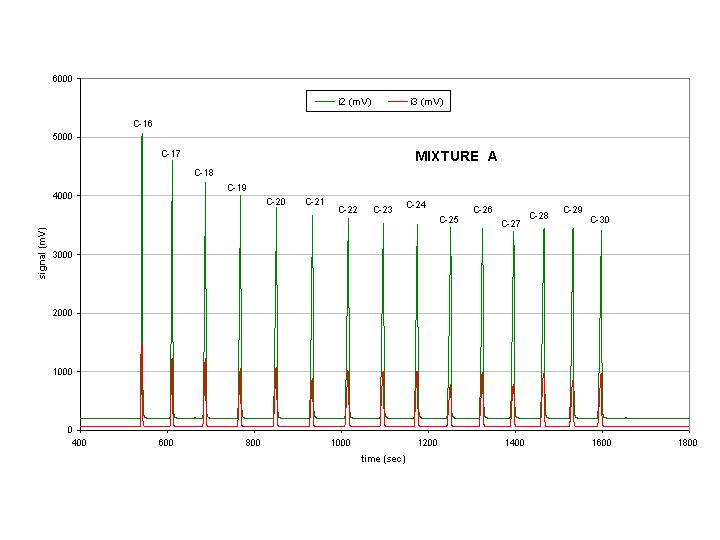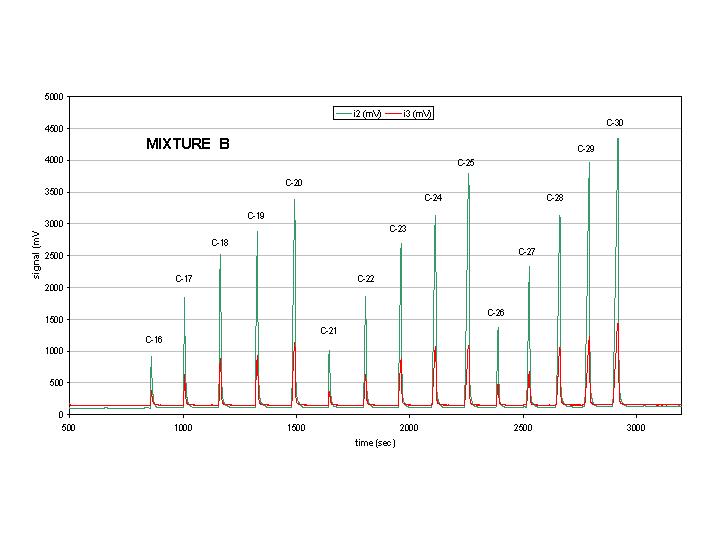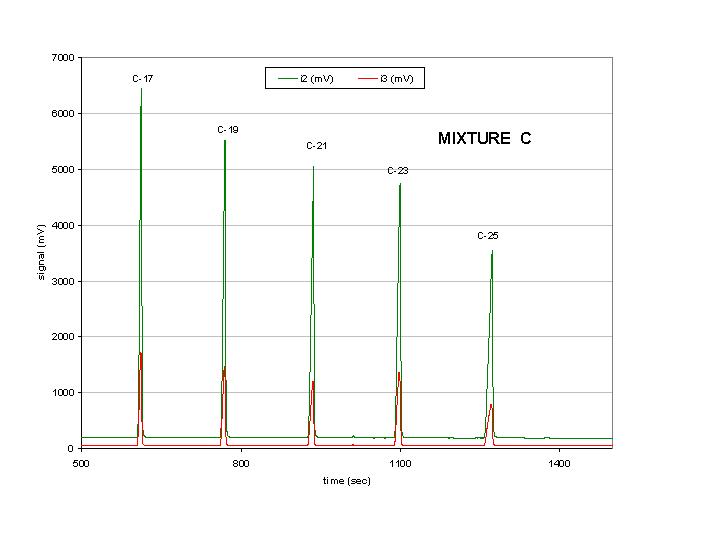How do I open sealed glass tubes containing hydrocarbon gases?
Various pure methanes and higher hydrocarbon gases are sealed at about ambient pressure in 9 mm o.d. Pyrex® glass tubes with an internal volume of at least 10 cm3 per tube. Each tube has a slender glass appendix at one end that can be easily snapped off for opening.
A tube cracker can be used to open the ampoule into a vacuum system (e.g., see: DesMarais and Hayes, 1976. Tube cracker for opening glass-sealed ampoules under vacuum. Analytical Chemistry 48, 1651-1652. https://doi.org/10.1021/ac50005a062).
Alternatively, hydrocarbon gases can be transferred under water by scoring and breaking the tube and bubbling the gas (aided by an inverted funnel) into a water-filled inverted glass vial. Helium can be added to completely fill the vial under water before closing the vial with a septum and a crimp-seal. A gas-tight syringe can subsample the hydrocarbon gas through the septum. The syringe should have a stopcock at its end to close off the syringe barrel before pulling the syringe needle out of the septum, in order to avoid air contamination. This simple technique renders gas at 100 % relative humidity. If needed, water can be frozen out by cooling the lower part of the methane-containing glass vial in dry ice before piercing the septum (kept at room temperature) with the syringe needle for subsampling of gas. Only a limited amount of liquid water should be in the vial during freezing, or the expanding ice may break the glass.
Using flexible bags for dilution of hydrocarbon gases
Flexible bags (e.g., Tedlar®) can be used to dilute a hydrocarbon gas into various other pure gases (He, N2, or "zero air") to ppm or part-per-thousand levels. Gas can first be moved from the glass tube to a septum-capped vial such as an exetainer or serum glass bottle using the underwater technique mentioned earlier, followed by the use of a gastight syringe to inject a small portion (0.05 to 1 mL) into a 1-L Tedlar® bag. Thorough mixing can be accomplished by first filling the Tedlar® bag partially with the diluent, then injecting the methane (or another pure gas), and finally filling the remainder of the bag with the diluent expecting the turbulence to mix the two gases. The solubility of methane, ethane and propane in water is small. We can store these gases in septum-capped glass vials for at least one month with no discernible isotopic changes by leaving a small volume of water in the exetainer and storing the bottle upside-down to let water fully cover the septum. This technique offers sufficient time to repeatedly sample the gas, make dilutions and check the reproducibility of techniques.
Higher n-alkanes
Higher n-alkanes are available either pure as liquid or solid substances, or as dissolved mixtures of selected n-alkanes in hexane (mixtures are discussed separately below). Pure n-alkanes are flame-sealed in glass ampoules or capillaries, or crimp-sealed in glass vials. Some n-alkanes are stored as a drop of solidified wax at the end of a glass stick inside of a crimp-sealed glass vial. Hexatriacontane (i.e. C-36 n-alkane) is a lightweight powder that may be difficult to weigh. If necessary, gently melt the powder and pour the melt onto a sheet of cold and clean (e.g., pre-annealed) heavy-duty aluminum foil. The solidified wax can be peeled off the foil, fragmented, and filled back into a glass vial.
How do I open a sealed glass capillary?
Sealed glass capillaries contain between 5 and 50 mg of n-alkane. Remove the label with a sharp blade. Carefully score the capillary at several positions with a scoring knife to weaken the glass. Wipe the outside of the capillary with a clean solvent, dry off the solvent, weigh the capillary, and place the capillary into a clean glass flask. Use a clean glass or metal tool to push against and fragment the capillary. Add clean solvent and gently heat the flask to thoroughly dissolve the contents of the fragmented capillary into the solvent. Recover the glass fragments from the solution with clean forceps, dry, then weigh the dry fragments in order to calculate the amount of n-alkane in solution. Adjust the solvent volume as needed to arrive at the required concentration.

Mixture A
Currently available mixtures of types A, B and C are characterized compositionally and isotopically in the rightmost columns of the following listing: n-Alkanes. All mixtures of types A, B and C are using the solvent hexane and may share some of the same pure dissolved n-alkane components. However, as older batches of pure n-alkanes become exhausted, newer mixtures contain replacement batches of individual, dissolved n-alkanes with different δ-values.
Download Certificate mix A5
Download Certificate mix A6
Download Certificate mix A7
Download Certificate mix A8

Mixture B
Mixtures of type A (i.e. 15 dissolved n-alkanes C-16 to C-30 in equal concentrations; see chromatogram of type A shown above) and type C (i.e. 5 dissolved n-alkanes C-17, 19, 21, 23, 25 in equal concentrations; see chromatogram of type C shown above) contain ca. 100 μmol of hydrogen H2 per compound per milliliter of solution. This is equivalent to approximately 1.4 mg of each n-alkane per milliliter of solution. These solutions are suitable for establishing the precision and accuracy of a GC-irm-MS instrument.
Download Certificate mix B4
Download Certificate mix B5

Mixture C
Mixtures of type B contain 15 dissolved n-alkanes (C-16 to C-30) with increasing concentrations along three pentads (see chromatogram of type B shown above) covering a five-fold range of concentrations from 20 nmol H2 to 100 nmol H2 per compound per milliliter of solution. This mixture is designed specifically to test the accuracy of H3+ corrections in hydrogen-isotope-IRMS (Sessions et al., 2001a, Determination of the H3 factor in hydrogen isotope ratio monitoring mass spectrometry. Analytical Chemistry 73 (2), 200-207. https://doi.org/10.1021/ac000488m; Sessions et al., 2001b, Correction of H3+ contributions in hydrogen isotope ratio monitoring mass spectrometry. Analytical Chemistry 73 (2), 192-199. https://doi.org/10.1021/ac000489e). In addition, the solution can be used to measure the H3+ factor under conditions closely matching those experienced by analytes.
Download Certificate mix C4
Download Certificate mix C5
How do I use n-alkane mixtures for calibration?
Typically an n-alkane mixture is injected between samples. The n-alkanes in the mixtures vary in δ2H by over 200 per mil, and have been calibrated relative to both VSMOW and SLAP standards. The n-alkanes can therefore be used to normalize isotopic measurements to the common VSMOW-SLAP scale. The following example is based on experience and measurements using a customized Finnigan MAT 252, but similar observations are expected from Finnigan Delta +XL and newer mass spectrometers (Alex Sessions, pers. comm.). For example, when using a C-16 to C-30 mixture (types A or B), C-18 and C-28 can serve as reference peaks with assigned δ2H values. The other δ2H values are then calculated by the computer relative to C-18 and C-28. The resulting individual raw δ2H values determined by GC-irm-MS can be plotted versus those determined by off-line combustion of pure compounds (as listed on the Certificate of Analysis). Ideally, the points fit well along a straight line with a linear regression R2 larger than 0.999. At WHOI, the slope of the line may vary from 0.92 to 1.01, but it is typically stable to about ± 0.02 over the course of one day. The Y-intercept varies from about -2 to +2 per mil. Thus there is no evidence for substantial internal fractionation in the WHOI instrument, although there is some δ2H -dependent effect which causes the slope of the line to vary. For each day, a normalization served to calibrate the instrument with regard to a particular slope and intercept (Alex Sessions, pers. comm.).
What can be the reason for unexpectedly small peak size?
Normally, n-alkane peak heights should be in the 2 to 6 V range (m/z = 2). For low-molecular n-alkanes which are not fronting, 100 ng of injected on-column should yield ~1 V (= 10 nA) peak height for mass 2. The following checks are recommended if peaks appear to be too small: 1. Check for leaks with an He sniffer through a GC temperature sequence while using the mass spectrometer to measure argon to see if leaks are opening up as the GC oven heats (sometimes a ferrule is tight at one temperature and opens up at higher or lower temperature). 2. Confirm the concentration of n-alkanes in your n-alkane mixture, either by running the mixture on a different GC (perhaps with an FID), or make your own comparative concentration standard using your own n-alkanes and solvent. Higher molecular weight n-alkanes may not completely dissolve in hexane if the temperature is too cold. 3. Sometimes problems occur in an open split when the split ratio is affected by the movable capillary slipping up or down. 4. The temperature of the TC unit might be lower than the controller is indicating, and thus the conversion of hydrocarbons to H2 may be limited. As a test, methane can be injected and mass 16 be monitored.
How do I store an n-alkane mixture?
Partial evaporation of the solvent hexane from an open glass ampoule containing an n-alkane mixture can be avoided by transferring the mixture into a different container that can be closed tightly for storage. Some laboratories prefer glass containers fitted with Mininert® valves (e.g., https://www.restek.com/) that allow the insertion of a syringe needle through a narrow valve opening for taking samples for injection. The vapor pressure of hexane can be reduced by storage of containers in a refrigerator.
Another possibility is to store an opened glass ampoule containing an n-alkane mixture upright in another tightly closed glass vial that contains some pure hexane at its bottom. The headspace will be saturated with hexane vapor, thus limiting the evaporation of hexane from the glass ampoule.
Why is there no Safety Data Sheet (SDS) for the n-alkane mixtures?
It is unpractical to issue a single SDS for the solvent and the 5 to 15 individual dissolved n-alkanes. The solvent hexane constitutes more than 99 wt. % of each mixture. From a practical point of view, the SDS of hexane is the single most relevant SDS. The dissolved n-alkane components are present in negligible concentrations and represent non-hazardous oily or waxy, inert compounds.
What are the contaminant peaks in the n-alkane mixtures?
All mixtures of types A, B and C are using pure hexane from dedicated bottles that have developed small concentrations of contaminants over the years of storage. A Burdick and Jackson solvent guide contains a chromatogram detailing those peaks as the result of auto-oxidation of hydrocarbons (i.e. hexane). The peaks correspond to a class of compounds called hydroperoxides. Passing a sample of the hexane through a pipette packed with freshly baked glass wool and silica gel filter can remove the contaminant peaks. However, the position of the contaminant peaks does not interfere with the n-alkane peaks in mixtures of types A, B and C, and therefore a cleanup of the original solvent is deemed unnecessary.
Which GC program and column should I use for aliphatics?
Hardware and GC-programs vary widely among laboratories. However, some users have provided examples: GC-program for n-alkane mixtures: Injection 50 °C in split mode, split flow 50 milliliter/min, oven 100 °C, ramp 20 °C/min to 180 °C, ramp 5 °C/min to 315 °C, hold 16 min. Some laboratories inject in splitless mode and inject 2 or more microliters of sample. In that case, the n-alkane mixtures can be diluted 10-fold. GC-columns for liquid injections: 0.32 mm ID, film thickness of 0.25 to 1.0 μm, length 15 to 60 m. Most commonly 30 m, 0.32 mm ID, 0.25 um film thickness. It is recommended to use a low column bleed GC-MS column with cross-linked stationary phases designed for MS work. A DB-1 type column with a 1-μm film thickness has a high capacity for alkanes and can reduce peak fronting as a consequence of overloading. Many laboratories prefer the versatility of a slightly more polar DB-5 type column.
Why is the δ2H value of first eluted n-alkane not measured correctly?
Several groups reported that the δ2H value of the first eluted compound (C-16 n-alkane) in mixtures of types A, B and C seems to be systematically shifted and should be ignored. The problem is likely attributed to conditioning and/or memory effects and can be mitigated if a sacrificial C-14 or C-15 n-alkane is co-injected to serve as the initial "throw-away peak" to condition the system (Nikolai Pedentchouk, pers. comm.). Inter-peak memory effects in compound-specific hydrogen stable isotope analysis by GC-TC-IRMS have been documented (Wang and Sessions, 2008, Memory effects in compound-specific D/H analysis by gas chromatography/pyrolysis/isotope-ratio mass spectrometry. Analytical Chemistry 80 (23), 9162-9170. https://doi.org/10.1021/ac801170v). Systematic δ2H changes with peak size were observed as the peak size (mass 2 area) for an artificially 2H-enriched analyte (δ2H = +650 ‰, mass 2 at ~5000 mV) increased by a factor of 10. The measured δ2H values systematically increased by ~130 ‰ and trended toward a constant value at still higher concentrations. The identified culprit is a “background hydrogen” component with a δ2H value in the range of -250 to -200 ‰ that mixes with the analyte hydrogen.
As a result, the measured δ2H value for analytes with δ2H > -200 ‰ is smaller than the real value due to the involvement of a more 2H-depleted background hydrogen. The influence of background hydrogen is diminished in larger peaks as background hydrogen is diluted. At the same time, the influence is enhanced for small analyte peaks with strong 2H-enrichment. Background hydrogen may derive from a combination of column bleed, water in the carrier gas and/or air leaks, and a slow release of resident hydrogen from pyrolysis tubing, all of which are likely to vary between different labs and over the use of instruments. While it is difficult to quantify the abundance and δ2H value of background hydrogen in individual GC-TC-IRMS systems, its isotopic influence on measured δ2H values can be accounted for by using calibration and normalization standards with similar δ2H values and peak sizes as those of peaks of unknown samples. Bilke and Mosandl offered additional information on conditioning, memory effects, and the need for proper reference materials (Bilke and Mosandl, 2002, Measurements by gas chromatography/ pyrolysis/mass spectrometry: fundamental conditions in 2H/1H isotope ratio analysis. Rapid Communications in Mass Spectrometry 16 (5), 468-472. https://doi.org/10.1002/rcm.599).


